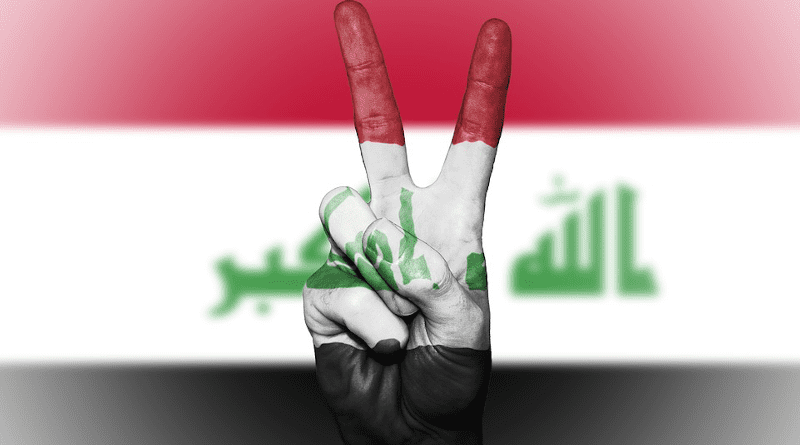Why Is World Silent On Iraq’s Tiananmen? – OpEd
By Arab News
By Dalia Al-Aqidi*
It has been 32 years since the Tiananmen Square massacre in Beijing. At the time, thousands of students were demonstrating peacefully in the Chinese capital, demanding democracy, freedom of speech and a free press in their country. Soon enough, the world witnessed one of the most brutal protest crackdowns in history, as the Chinese communist regime ordered its military forces to mow down the protesters and clear the square.The death toll among innocent young people may never be known, but estimates range from the hundreds to the thousands.
The Chinese Communist Party’s crime against its own people sparked global condemnation and prompted the US Congress to vote on imposing economic sanctions against Beijing for human rights violations.
After all these years, images of the infamous massacre remain in our memory, especially the iconic photo of a young Chinese man who challenged the CCP’s brutality by standing — alone and unarmed — in the path of a column of tanks as they left the square.
History repeated itself in 2019. This time it was in Iraq, where thousands of protesters took to the streets of Baghdad and the southern provinces to express their anger at the corrupt government, which had failed to provide them with essential public services and had opened the country up to foreign interference.
This month marks the second anniversary of the Iraqi Tiananmen.
While Iraqis cast their votes in Sunday’s early elections, which were called in response to the mass protests, the memory of Tahrir Square has been gradually erased from the global conscience, as if the thousands of Iraqi victims either did not exist or did not deserve to live.
The protest movement began in response to then-Prime Minister Adel Abdul Mahdi’s decision to demote Iraq’s famous counterterrorism chief, Lt. Gen. Abdul-Wahab Al-Saadi. Many Iraqi youths viewed that decision as a symbol of the extent of the rampant financial and administrative corruption in all government branches and political factions.
The people of Iraq could clearly see the level of foreign influence, Iranian in particular, and its impact on the decisions of their leaders, who were more loyal to the regime in Tehran than their own citizens. Fueled by anger, despair and the desire for change, the demonstrations grew more significant and included hundreds of thousands of people in the historic Iraqi capital and the centers of other provinces, such as Basra, Najaf, Dhi Qar, Maysan and Babil.
Under the watchful eyes of the government and pro-Iran militias, Baghdad’s Tahrir Square, near the heavily fortified Green Zone, became the home of the biggest and longest demonstration, as part of what became known as the Tishreen (October) movement. Approaching the bridge that leads to the central government offices, the young, peaceful protesters were met with lethal force by anti-riot and security forces, who opened fire on them.
A fact-finding report issued by Amnesty International confirmed that the Iraqi forces had deployed deadly tear gas grenades, among other weapons, against the protesters in Baghdad. “The organization’s Digital Verification Corps geolocated and analyzed video evidence from near Baghdad’s Tahrir Square documenting the fatalities and injuries — including charred flesh and ‘smoking’ head wounds. Its military expert identified the types of tear gas grenades being used as two variants from Iran and Serbia that are modeled on military grenades and are up to 10 times as heavy as standard tear gas canisters, resulting in horrific injuries and death when fired directly at protesters,” the report read.
The protests led by Iraq’s young people, who were seeking a brighter future, provoked the leaders of the pro-Iranian militias to unleash their terrorists and hunt the activists down, kidnapping, torturing and assassinating them to terrorize whoever dared to challenge their authority or criticize their leaders.
From October 2019 until today the massacre continues, while the international community has failed to stand by the innocent victims or hold the responsible parties accountable for their horrific human rights violations.
On Saturday, the body of 15-year-old activist Haider Mohammed Al-Zamili was found floating in the river in Diwaniyah, the capital city of the southern province of Al-Qadisiyyah, four days after he disappeared. The teenage activist’s last Facebook post was a cartoon depicting the followers of Shiite leader Muqtada Al-Sadr as sheep. His death sparked widespread criticism on social media and prompted direct accusations of Al-Sadr being responsible.
The new generation that is bleeding in the Iraqi streets and alleys will one day be the country’s political class. Each one of them will face world leaders, international organizations and human rights activists with one question: “Where were you when more than 600 of us were killed and 30,000 injured during our peaceful, legitimate protests?”
The Tishreen revolutionaries have learned that they are on their own and, apparently, their lives have no global value. For example, when a member of the terrorist group Hamas dies, rallies erupt in several cities worldwide. Meanwhile, certain members of the US Congress urge the world to take action against Israel, calling for new legislation, while far left-leaning media outlets launch support campaigns.
The Iraqi Tiananmen is an ongoing massacre that the world has decided to overlook and hold its peace forever.
- Dalia Al-Aqidi is a senior fellow at the Center for Security Policy. Twitter: @DaliaAlAqidi

